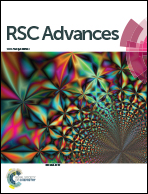Ruthenium(ii) complexes containing a phosphine-functionalized thiosemicarbazone ligand: synthesis, structures and catalytic C–N bond formation reactions via N-alkylation†
Abstract
A series of ruthenium(II) complexes incorporating a thiosemicarbazone chelate tethered with a diphenylphosphine pendant have been studied. Thus, [(PNS-Et)RuCl(CO)(PPh3)] (1), [N,S-(PNS-Et)RuH(CO)(PPh3)2] (2) and [(PNS-Et)RuCl(PPh3)] (3) were synthesized by reactions of various RuII precursors with 2-(2-(diphenylphosphino)benzylidene)-N-ethylthiosemicarbazone (PNS-Et). However, complexation of PNS-Et with an equimolar amount of [RuCl2(dmso)4] resulted in two different entities [(PNS-Et)RuCl(dmso)2] (4) and [(PNS-Et)2Ru] (5) with different structural features in a single reaction. All the RuII complexes have been characterized by analytical and various spectroscopic techniques. Compounds 1–5 were recrystallized, and the X-ray crystal structures have been reported for 1, 2 and 5. In the complexes 1 and 3–5 the ligand coordinated in a tridentate monobasic fashion by forming PNS five- and six-membered rings, whereas in 2, the ligand coordinated in a bidentate monobasic fashion by forming a strained NS four-membered ring. Furthermore, compounds 1–5 showed catalytic activity in N-alkylation of heteroaromatic amines. Notably, complexes 1–3 were found to be very efficient catalysts toward N-alkylation of a wide range of heterocyclic amines with alcohols. In the presence of a catalytic amount of 2 with 50 mol% of KOH, N1,C5-dialkylation of 4-phenylthiazol-2-amine has been investigated. Reaction of in situ generated aldehyde with amine yields the N1,C5-dialkylated products through the hydride ion transformation from alcohol. Complexes 1–3 also catalyzed a variety of coupling reactions of benzyl alcohols and sulfonamides, which were realized often with 99% isolated yields. Advantageously, only one equivalent of the primary alcohol was consumed in the process.


 Please wait while we load your content...
Please wait while we load your content...